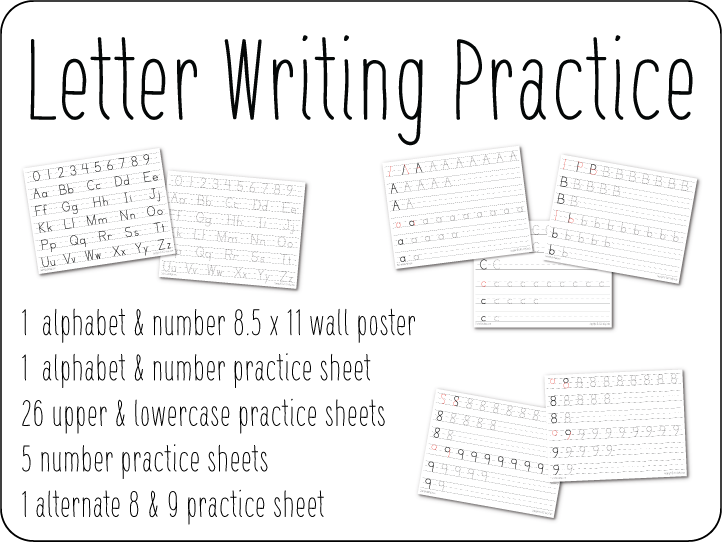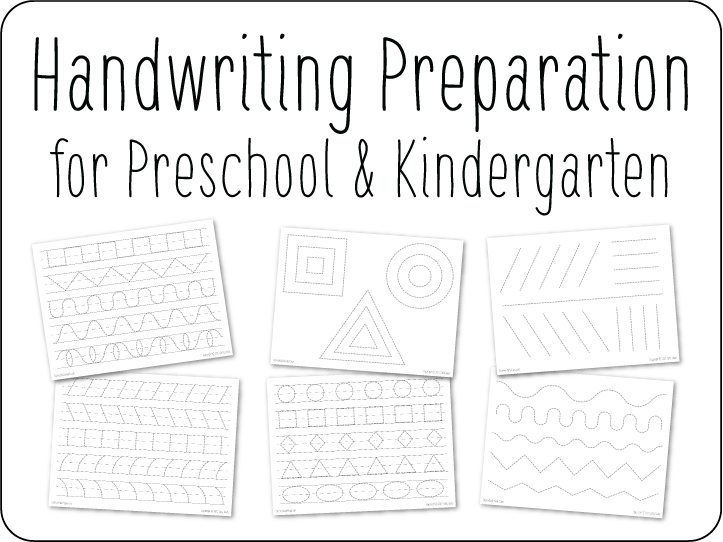Handwriting is a foundational skill your child will use for the rest of their life. Their first few years of writing are crucial to developing good handwriting. Sloppy writing will quickly become habitual if left unchecked. Unteaching sloppy writing habits can prove to be more difficult than teaching correct writing in the first place.
You can help your child improve their handwriting skills while they are young and learning. In this post, we share with you 8 tips on how you can accomplish this important task. It may not be easy, but it is worth the time and effort you put into it.
Easily the most important part of learning good penmanship is practice, so we created a 35-page PDF full of practice sheets for your little learner. The best part? They are free to use! Included in this file are:
- 1 alphabet & number 8.5 x 11 wall poster
- 1 alphabet & number practice sheet
- 26 upper & lowercase practice sheets
- 5 number practice sheets
- 1 alternate 8 & 9 practice sheet

If you would like to share this file, please link to it from this blog post. Do share the file itself. You may print and use these practice sheets for personal and classroom use as many times as you desire. These practice sheets are protected by copyright, you are prohibited from using any part of these practice sheets for financial gain in any way.
Tip 1: Assess Your Child’s Pencil Grip
Proper pencil grip is a big part of learning to write well. If your child is unable to hold their pencil correctly it becomes difficult for them to form their letters. My son had this problem for a few months when he first started writing. He did not have the natural tripod grasp my daughter had from a very early age. Writing practice was very frustrating for him because his grip on the pencil made it difficult for him to form proper letters. He was not yet ready to begin handwriting.
After I noticed that the problem was the way he held his pencil, we worked on holding his pencil in a way conducive to letter writing with the help of rubber pencil grips and thicker pencils. We worked on following shapes and lines instead of letters. Eventually, a better pencil grip became a habit and he no longer needed the rubber grips to help him, and we began letter practice again. He still likes to use thick pencils as that is more comfortable for him, but his pencil grip is much improved.
Give your child a pencil and ask them to draw a circle, a square, and a triangle. Watch how they hold their pencil while they draw. If they hold the pencil in a way that makes pencil control difficult they may need to work on their pencil grip and control before proceeding with learning to write their letters. Have them practice following curved lines, straight lines, zig-zags, and large shapes. We made some Handwriting Preparation Practice Worksheets for preschool and early Kindergarten age children to help prepare them for handwriting.

Here are some other resources we found for helping with your child’s pencil grip:
5 Tips for Correcting Your Child’s Pencil Grasp
Five Strategies to Improve Pencil Grasp for School-Aged Children
Tip 2: Teach Proper Writing Posture
Poor posture while writing will make proper letter formation more difficult. Your child should have both feet flat on the ground (use a small table or desk for younger children). Their legs should be facing the table/desk and their knees bent at 90°. Their back should be flat against the back of the chair. They should have their practice sheet tilted at an angle to the right for right-handed and to the left for left-handed with their non-dominant hand lightly rested on the paper so it does not move while writing.
There should be absolutely no slouching while letter writing. My 6-year-old son has a bad habit of slouching over and sometimes even laying his head down on the page while writing. We are still working on this. I show him how much better he writes when he doesn’t slouch and sits straight in his chair.
Here are some more resources on how to improve your child’s posture when writing:
The Importance of Good Sitting Posture for Handwriting
The Importance of Posture and Positioning for Handwriting
Tip 3: Teach Your Child Proper Letter Formation
Starting with proper letter formation can prevent you from the headache of having to correct too many mistakes in the future. Be consistent in letter formation so your child will not be confused or become lazy. If you see your child write their letters incorrectly go over proper letter formation again and again. Our 35-page Letter Writing Practice sheets shows proper letter formation so your child can learn each letter step-by-step.
You can use little rhymes when writing letters to help your child remember how to write them correctly. Here are a few letter rhymes we found to help little learners remember proper letter formation:
Alphabet Letter Formation Poems
Printable Letter Formation Poems
Tip 4: Have Your Child Practice Often
The key to achieving good penmanship is lots and lots of practice. Watch your child write their letters as they practice to ensure they are properly forming their letters as taught. Don’t have them do too much writing in a single sitting. The amount of time your child can be expected to sit through a practice session will change with age. Start out at 5 minutes per sitting a couple of times a day for Kindergarteners and work up to 10-minutes per grade level (10 for first grade, 20 for a second, etc.) a couple of times a day.
Try to have them practice daily. You can choose to work on a single letter until it is consistently mastered or change the letter every day until you work your way through the alphabet and then start it over again from the beginning.
As your child builds up their letter-writing stamina, they may experience hand cramping and tightness. Have a piece of play dough or silly putty nearby that they can squeeze and stretch to help relieve that crampy feeling in their hands from writing. Let it sit there in view as an incentive to finish their practice sheet.
Tip 5: Correct Your Child’s Writing Mistakes
It is important to review the practice letters your child wrote and show them what they need to work on. Are they beginning their circle shapes from the bottom? Show them where to start from the top. Are their G’s consistently missing the top line? Show them how to correctly write a G and explain what points of the letter need to hit the lines.
Sometimes your child will write well for a while and then slip into some sloppy writing out of laziness. This sloppiness should be addressed quickly and corrected. Add a page or 2 of practice writing when you see these sloppy habits pop up. Remind them not to be lazy in their writing.
Tip 6: Teach Your Child to Self-Correct Their Writing
Learning to self-correct mistakes will teach your child to see errors in their own writing. In order to help my 6-year-old son identify the mistakes in his letter writing, I like to ask him which letters he thinks he can do better. This allows him to be objective in his review of the letters he wrote and look for his sloppy mistakes.
He will point out where he went above or below the lines, where his “o” was squished a bit too much, or where his “L” wobbled on the way down. He will then go back and correct his work proving to himself that he can do a better job.
I have seen how this practice has worked wonders for both his penmanship and his confidence in letter writing. Now when he writes his letters, he points out his mistakes on his own and corrects them immediately.
Tip 7: Have Patience with Your Child
It can be very frustrating teaching the same thing over and over again. Believe me, I have been there many times myself. Losing patience with your child will only cause them frustration and cause them to hate writing since they can’t seem to please you. If you find yourself getting frustrated, step away and come back to it when you and your child are feeling up to it.
Let your child know that you understand it is hard to learn something new and that you are there to help them learn it. I always tell my kids: “Just because it’s hard doesn’t mean it’s not worth doing. Some things are hard to do, but they are worth it.”
Tip 8: Encourage Your Child
Practicing the same thing over and over again can become mundane and boring. Encourage your child by offering praise when they write their letters exceptionally well. This will make them want to strive to do well for your praise. For many children, praise is all the incentive they need. Other children need more than just your praise as encouragement.
For those who need more encouragement, offering an incentive for good work when they complete a practice sheet is a great way to encourage them. Offering a small treat like an M&M, fruit loop, or raisin for each letter that they write well is a fun incentive. Let them point out their best letters and worst letters. Give them a chance to correct the worst letters for more treats.
Another great way to encourage your child is to compare their current writing to where they started out. Save practice sheets when they start learning and pull them out periodically to see how much they have improved. Rave at their improvement to help build their confidence in their writing ability.
We hope you found this article helpful and informative. Please check back often as we strive to help you be profitable to your family, community, and Christ. Don’t forget to print out your copy of the 35-page Letter Writing Worksheets. I am sure they will be useful to your little learners.
